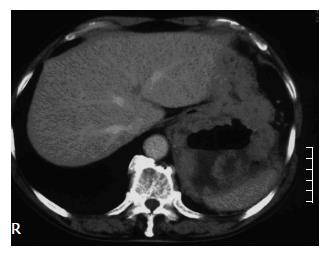Copyright
©2007 Baishideng Publishing Group Co.
World J Gastroenterol. Apr 28, 2007; 13(16): 2385-2387
Published online Apr 28, 2007. doi: 10.3748/wjg.v13.i16.2385
Published online Apr 28, 2007. doi: 10.3748/wjg.v13.i16.2385
Figure 1 Endoscopic view of a gastric submucosal tumor in the fornix, with a fistula to the gastric lumen.
Within the submucosal tumor was a great deal of turbid, yellow fluid oozing from the fistula.
Figure 2 Upper gastrointestinal tract X-ray revealing a large cavity, about 7 cm × 8 cm, penetrating into the gastric lumen.
Figure 3 Enhanced com-puted tomography (CT) scan of the abdomen revealing a large central cavity in the tumor partially filled with fluid, and an irregular thickening of the gastric wall in the posterior aspect of the fundus extending into the left subphrenic space.
Figure 4 Photomicrographs of biopsy specimens from the fistula showing spindle-shaped cells (A) (HE, × 200), immunohistochemical staining showing a diffuse positive signal for KIT (B) (× 100), a diffuse positive signal for CD34 (C) (× 100), and MIB-1 (D).
The labeling index (L.I) was 18% (× 200).
Figure 5 Gross appearance of a 10 cm × 12 cm × 7 cm solid tumor with a large amount of central necrosis and a fistula to the gastric lumen.
- Citation: Osada T, Nagahara A, Kodani T, Namihisa A, Kawabe M, Yoshizawa T, Ohkusa T, Watanabe S. Gastrointestinal stromal tumor of the stomach with a giant abscess penetrating the gastric lumen. World J Gastroenterol 2007; 13(16): 2385-2387
- URL: https://www.wjgnet.com/1007-9327/full/v13/i16/2385.htm
- DOI: https://dx.doi.org/10.3748/wjg.v13.i16.2385

















